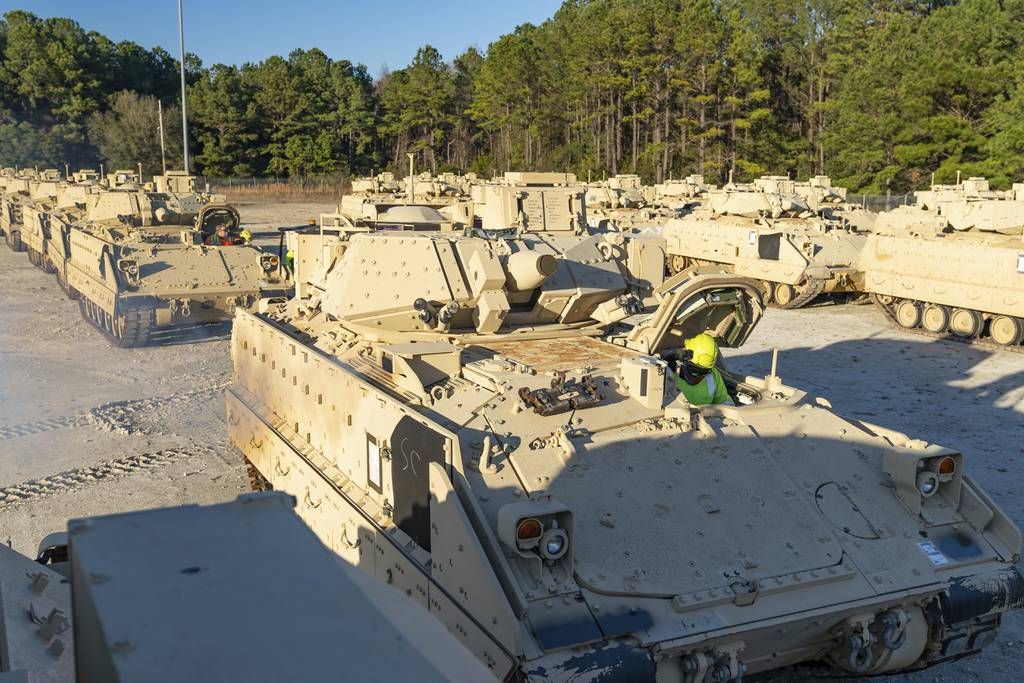Here’s who will move forward in the Bradley replacement competition
WASHINGTON — American Rheinmetall Vehicles and General Dynamics Land Systems will continue on in the U.S. Army’s pursuit of an Optionally Manned Fighting Vehicle to replace the Bradley infantry fighting vehicle, the Army said Monday.
The service has renamed the envisioned platform the XM30 Mechanized Infantry Combat Vehicle.
Each team is expected to develop detailed designs over the next two years, followed by a competitive prototyping phase beginning in the first quarter of fiscal 2025, during which the teams will build a minimum of seven prototype vehicles with an option to build four more.
The Army said the total value of both contracts is approximately $1.6 billion; the overall program is expected to be worth about $45 billion.
BAE Systems, Oshkosh Defense and Point Blank Enterprises said they submitted bids, but were not selected by the Army to continue.
Those teams all participated in a 12-month preliminary design phase that produced concepts for how each would design a new vehicle if selected. The two teams now moving into the detailed design phase were also a part of that preliminary design phase.
The Army released a request for proposals to industry in the summer of 2022, and bids were due in November.
The plan was to choose three teams to move into the detailed design and prototyping phases of the competition, but Doug Bush, the service’s acquisition chief, said the Army wanted to ensure it had enough resources to keep the program on solid footing while ensuring competition all the way to a production decision.
“The original plan focused on maintaining competition as long as possible,” Bush said at a June 26 press briefing. “We’re still doing that. We’re just doing it with two instead of three for these two phases.
“We now have information we didn’t have before, including the bids themselves, which informed us about the overall resources required by the program,” he continued. “Finally we want to make sure, based on what we’ve learned over the years doing programs, that we have two fully resourced and standing-on-firm-ground companies going forward to do the [engineering and manufacturing development] work here.”
American Rheinmetall Defense’s team includes Textron Systems, RTX, L3Harris Technologies and Allison Transmission as well as artificial intelligence-focused company Anduril Technologies. All together they are known as Team Lynx, a nod to Rheinmetall’s vehicle that was the company’s planned original bid sample in the Army’s earlier attempt to hold a competition.
That competitive effort ended in the fall of 2019 when only General Dynamics Land Systems was able to deliver a physical bid sample to the Army by deadline. Rheinmetall, based in Germany, ran into issues delivering the Lynx and had to drop out of the competition.
With only one bid sample, the Army decided to scrap the competition. The service reworked its strategy in a lengthier, five-phase effort that began with the initial design phase in 2021 and is now moving into the detailed design phase, followed by the prototyping phase. Testing and production will be the final phases of the competition.
Now American Rheinmetall and GDLS will have another chance to face off for a chance to build the Bradley’s replacement. The service plans to award a contract in FY27 to one team, with fielding beginning in FY29.
GDLS is teamed up with GM Defense; Applied Intuition, a specialist in modeling and simulating autonomy for the automobile industry; and AeroVironment, which is providing its Switchblade loitering munitions for integration into the design. GDLS also continues to work with General Dynamics Mission Systems to incorporate networks, radio gear and cyber capabilities.
Matt Warnick, American Rheinmetall’s managing director, told Defense News the company, with its teammates “will deliver a vehicle with the most modern protection, firepower, mobility, and power generation capabilities available.”
Gordon Stein, vice president and general manager of U.S. operations at GDLS, told Defense News in a statement that his company’s “highly affordable OMFV development approach maximizes performance to the Army’s requirements, and delivers a vehicle that is purpose-built for the mission.”
BAE Systems decided not to participate in the previous competitive effort, but the Army chose it for the first phase of the new competitive effort. The company’s team included Elbit Systems, QinetiQ and Curtiss-Wright.
Oshkosh Defense partnered with South Korean defense company Hanwha, which provided the chassis design based on its Redback infantry fighting vehicle. Rafael Advanced Defense Systems, QinetiQ and Plasan provided to Oshkosh technology from turrets to armor to autonomy, as well as command-and-control capabilities. And Pratt Miller, which Oshkosh bought in 2021, was also a teammate.
Point Blank submitted a bid for the detailed design phase without its teammate Keshik, after they ended their partnership for the OMFV competition. Point Blank successfully sued Keshik, leaving the latter unable to compete separately or with another team.
Because Point Blank could not use Keshik’s technology and concept designs going forward, it brought in RENK America to provide a powertrain solution. RENK, a German company, opened up shop in Muskegon, Michigan, in 2021 to build advanced mobility systems.
Point Blank also swapped out turret manufacturer John Cockerill with Kongsberg Defence and Aerospace. Palantir, a data analytics specialist supplying the Army with its Distributed Common Ground System, was also a Point Blank teammate.
The Army hasn’t fully cemented its requirements, but is seeking a hybrid vehicle featuring a suite of lethal capabilities to include a 50mm cannon, a remote turret, anti-tank guided missiles, machine guns employed through an advanced third-generation forward-looking infrared sensor and “intelligent fire control,” Brig Gen. Geoff Norman told reporters during the press briefing.
The new vehicle allows for a two-person crew with six seats for infantry troops. The vehicle and its passengers will be protected by integrated active protection systems, kitted armor and “innovative signature management capabilities from the very beginning,” Norman said.
Bush noted “the modular, open-system architecture [on the] XM30 will allow new, developing technology to be added to the vehicle if that technology matures.”
Jen Judson is an award-winning journalist covering land warfare for Defense News. She has also worked for Politico and Inside Defense. She holds a Master of Science degree in journalism from Boston University and a Bachelor of Arts degree from Kenyon College.
Source: Defense News


